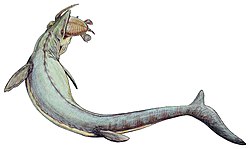| Peedee Formation | |
|---|---|
| Stratigraphic range: Early to Late Maastrichtian, | |
 | |
| Type | Formation |
| Sub-units | Rocky Point Member, Island Creek Member |
| Underlies | Castle Hayne Limestone |
| Overlies | Black Creek Group |
| Thickness | Up to 886 ft (270 m) |
| Lithology | |
| Primary | Glauconitic to argillic sandstone |
| Other | Claystone, limestone |
| Location | |
| Region | North Carolina, South Carolina |
| Country | United States |
| Type section | |
| Named for | Pee Dee River, type locality: Burches Ferry, South Carolina [1] |
The Peedee Formation is a geologic formation in North and South Carolina. A marine deposit representing an inner neritic environment, [2] named for exposures along the Great Peedee River, it preserves invertebrate (primarily belemnites, echinoderms and foraminifera) and vertebrate (primarily shark teeth, with some marine reptile remains) fossils dating to the Late Cretaceous (Maastrichtian). [1]
Contents
- Vertebrate paleobiota
- Cartilaginous fish
- Bony fish
- Reptiles
- Invertebrate paleobiota
- Echinoderms
- Molluscs
- See also
- References
- External links
The formation is notable for its occurrence of Belemnitella americana , known as the Pee Dee Belemnite (PDB), a long-standing standard in stable carbon isotope research. A single pterosaur femur, possibly an Azhdarchid, from the Peedee formation is one of the few pterosaur body fossils found in Eastern North America. [3]
The stratigraphy of the formation spans from the early Maastrichtian (in South Carolina) [4] to the late Maastrichtian shortly before the Cretaceous-Paleogene extinction event. The formation is divided into several members, including the early-mid Maastrichtian Rocky Point Member and the late Maastrichtian Island Creek Member. [2] Based on its fauna, it appears to be roughly concurrent with the Navesink Formation from New Jersey. [3]



































